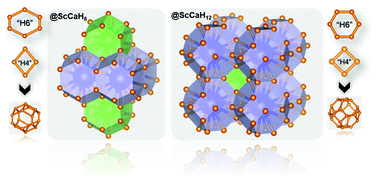Prediction of pressure-induced superconductivity in the novel ternary system ScCaH2n (n = 1–6)†
Abstract
Hydrogen-rich systems are currently thought to constitute the most promising potential high-temperature superconductor materials. Here, the high-pressure structure and superconductivity of the ternary hydrogen-rich system ScCaH2n (n = 1–6) are systematically investigated by using the prediction method of particle swarm optimization structure combined with first-principles calculations. As n increases, the electron local function (ELF) indicates that the hydrogen atoms in this system exhibit different behaviors corresponding to single H atoms, H2 molecules, graphene-like layers and, ultimately, H clathrate cages. The electron phonon coupling (EPC) calculation shows that the superconducting transition temperature for the hydrogen cage structures is much higher than that of other structures, which is mainly attributed to the increasing contribution of H in the cage structure to the density of states (DOS) at the Fermi level. With the ScCaH2n system we have found two potential high temperature superconductor structures: ScCaH8 and ScCaH12. For these two compounds, the corresponding Tc values reach around 212 K and 182 K, respectively, at 200 GPa. The ScCaH8 structure exhibits an H18-cage in which the length of four hydrogen bonds increases abnormally with increasing pressure, leading to a decrease in the Tc value after 200 GPa. The present work therefore demonstrates an unusual pressure-induced behavior and provides new ideas to guide the search for new high temperature superconductors in ternary hydrides.



 Please wait while we load your content...
Please wait while we load your content...